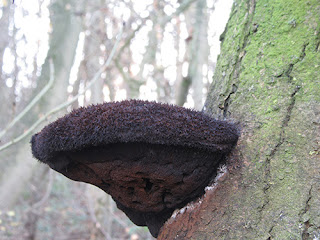I came across this during the late Summer at Elvaston Castle grounds in Derbyshire.
The grounds being full of mixed trees.
It really is beautiful. A lovely pure white like porcelain and with a very smooth texture on the outer surface of the cap. Much smaller in size than the Oyster Mushroom Pleurotus ostreatus.
The caps of the Pale Oyster are 2-10 cm in diamater, whereas the Oyster Mushroom cap can reach up to 14 cm across. The stem of the Pale Oyster is also smaller reaching a height of just 1.5 cm and can be positioned off-centre from the cap. It can have a woolly texture near the base. This is also pure white with very decurrent gills. These gills are narrow and close. It has no distinctive odour.
With age the Pale Oyster can turn more greyish brown, including the gills and the margin of the cap might start to split.
It tends to grow in small groups on broad-leaf stumps, trunks and on trees that have been felled. This mushroom is uncommon.
 |
| A small group showing the caps |
 |
| Showing decurrent gills |
This group were very immature.






























